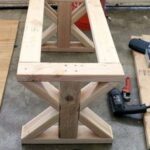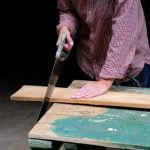Are you looking for a versatile and beautiful finish for your woodworking projects? If so, then learning how to apply shellac in woodworking is a skill worth mastering.
Shellac is a natural resin that can be used as a wood finish, and it offers several benefits such as ease of application, quick drying time, and a stunning, glossy look. In this article, we will explore the world of shellac woodworking, including what shellac is, its uses, benefits, types, application techniques, and maintenance.
Shellac is a resin secreted by the lac bug found in India and Thailand. It has been used for centuries as a versatile wood finish due to its quick-drying nature and beautiful appearance. In this section of the article, we will delve into what exactly shellac is and how it is used in woodworking projects. Whether you are a novice woodworker or an experienced craftsman looking to expand your finishing techniques, understanding the basics of shellac woodworking is essential.
When it comes to selecting a wood finish for your projects, there are many options available. However, shellac offers numerous advantages that make it stand out among the rest.
From its ability to enhance the natural beauty of wood to its easy repairability and versatility in use with other finishes, there are plenty of reasons why shellac is a popular choice among woodworkers. In the following sections of this article, we will explore these benefits in detail and provide you with insights on how to achieve professional results with this classic finish.
What Is Shellac and Its Uses in Woodworking
Shellac is a natural resin secreted by a female lac bug found in India and Thailand. It has been used for centuries as a versatile and durable finish for woodworking projects. Shellac is dissolved in alcohol to create a solution that can be brushed or sprayed onto wood surfaces, leaving behind a beautiful and protective layer.
One of the key uses of shellac in woodworking is as a sealer and primer. It can be applied to bare wood to seal the surface and prevent the wood from absorbing too much stain or finish. This makes it an excellent choice for preparing wood before applying other finishes such as varnish or lacquer. Additionally, shellac can be used as a standalone finish, providing a warm and lustrous appearance to wooden furniture, trim, and other objects.
The versatility of shellac extends beyond just finishing wood surfaces. It can also be used as a glue, specifically in French polishing techniques where it is combined with pumice or rottenstone to create a fine abrasive paste for rubbing out finishes on wood. The ability of shellac to adhere to almost any surface makes it an essential product in any woodworking workshop.
| Benefit | Information |
|---|---|
| Versatile Finish | Can be used as sealer, primer, standalone finish, or in French polishing techniques |
| Natural and Durable | Made from natural ingredients and provides durable protection for wood |
| Adheres to Any Surface | Ability to adhere to almost any surface makes it essential in woodworking |
Benefits of Using Shellac in Woodworking Projects
Enhanced Natural Beauty
One of the major benefits of using shellac in woodworking projects is that it enhances the natural beauty of the wood. Shellac has a transparent appearance that allows the natural grain and color of the wood to shine through.
This makes it an ideal choice for showcasing the unique characteristics of different wood species, from the rich tones of mahogany to the light, delicate hues of maple. Whether you are working on furniture, cabinets, or decorative items, shellac can bring out the inherent beauty of the wood in a way that other finishes cannot.
Quick Drying Time
Another advantage of using shellac in woodworking is its quick drying time. Unlike some other finishes, which can take hours or even days to dry completely, shellac dries within minutes. This means that you can apply multiple coats in a single day, allowing you to finish your project much more quickly. The fast drying time also reduces the risk of dust or debris settling on the surface before it is fully dry, resulting in a smoother and more professional finish.
Versatility and Compatibility
Shellac is known for its versatility and compatibility with other finishes. It can be used as a standalone finish or as a sealer or primer for other finishes such as varnish or lacquer.
This flexibility makes shellac an essential tool for woodworkers who want to experiment with different techniques and achieve a wide range of looks and effects. Additionally, shellac is compatible with both water-based and oil-based products, making it a convenient option for those who work with various types of woodworking materials and finishes.
By understanding these benefits and knowing how to apply shellac woodworking enthusiasts can elevate their projects to new levels of artistry and craftsmanship. Whether you are a beginner or an experienced woodworker, incorporating shellac into your woodworking arsenal can open up endless possibilities for creating stunning pieces that stand out for their beauty and durability.
Types of Shellac and How to Choose the Right One
When it comes to shellac woodworking, choosing the right type of shellac is crucial for achieving the desired results. There are several types of shellac available on the market, and each one has its own unique characteristics and uses. Understanding the differences between them will help woodworkers select the most suitable shellac for their specific project.
Dewaxed Shellac vs. Waxed Shellac
One of the main distinctions between types of shellac is whether they are dewaxed or waxed. Dewaxed shellac is ideal for use as a sealer or topcoat because it dries hard and can be easily sanded. On the other hand, waxed shellac is softer and has a lower resistance to heat and water, making it more suitable for decorative finishes or touch-ups.
Blonde Shellac vs. Orange Shellac
Another consideration when choosing shellac is its color. Blonde shellac is derived from light-colored resin and is often used as a clear finish to preserve the natural look of wood. Orange shellac, on the other hand, contains a natural dye that adds a warm tone to wood surfaces, making it popular for enhancing the color of hardwoods such as cherry or mahogany.
Choosing the Right Type for Your Project
To choose the right type of shellac for your woodworking project, consider the wood species you are working with, as well as the desired finish and level of protection needed. Dewaxed shellac is recommended for high-traffic areas or items that will come into contact with moisture, while waxed shellac may be preferred for decorative applications.
Understanding these differences in types of shellac will allow woodworkers to make informed decisions when selecting the most suitable variety for their projects. By carefully considering factors such as dewaxed vs. waxed, blonde vs. orange, and specific project requirements, artisans can achieve professional results when applying shellac to woodworking creations.
Tools and Materials Needed for Applying Shellac
When it comes to applying shellac in woodworking projects, having the right tools and materials is crucial to achieving a professional finish. Before starting your project, it’s important to gather all the necessary items to ensure a smooth and successful application of shellac.
One of the key tools you will need for applying shellac is a good quality brush. Look for a brush specifically designed for use with shellac, as this will help to ensure an even application and minimize the risk of streaks or brush marks. Additionally, having a clean and lint-free cloth on hand can be useful for wiping away any excess shellac or smoothing out uneven areas.
In terms of materials, you will obviously need shellac itself. Shellac is available in various forms, including flakes, premixed liquid, and aerosol spray. The type you choose will depend on your personal preference and the specific requirements of your project. You will also need denatured alcohol to dissolve the shellac flakes if you opt for this form, as well as a suitable container for mixing the two together.
Another important material needed for applying shellac is sandpaper. Depending on the condition of the wood surface, you may need to sand it down before applying the shellac to ensure a smooth and even finish.
Having different grits of sandpaper on hand will allow you to prepare the wood properly before applying the shellac. By ensuring that you have all these essential tools and materials ready before starting your project, you can set yourself up for success in applying shellac in your woodworking endeavors.
Step-by-Step Guide on How to Apply Shellac to Wood
Shellac is a versatile and popular finish for woodworking projects due to its ease of application and beautiful results. If you’re new to using shellac in your woodworking projects, here is a step-by-step guide on how to apply shellac to wood.
Step 1: Prepare the Surface
Before applying shellac, it’s important to prepare the surface of the wood. This involves sanding the wood to remove any imperfections and create a smooth surface for the shellac. Start with a coarse-grit sandpaper and gradually work your way up to a fine-grit sandpaper for best results.
Step 2: Choose the Right Shellac
There are different types of shellac available, such as dewaxed shellac and premixed shellac. Consider the type of wood you are working with and the desired finish before choosing the right shellac for your project.
Step 3: Apply the Shellac
Using a natural bristle brush or a clean cotton cloth, apply a thin coat of shellac onto the wood surface in smooth, even strokes. Allow each coat to dry completely before applying another layer. Depending on the desired finish, multiple coats may be needed.
By following these steps on how to apply shellac woodworking, you can achieve a professional-looking finish on your woodworking projects while enhancing the natural beauty of the wood. With proper application and maintenance, your shellac-finished woodworking pieces will stand out for their durability and timeless appeal.
Tips and Techniques for Achieving a Professional Finish
Shellac woodworking is a popular finishing technique that can give your wood projects a professional and elegant look. Achieving a perfect finish with shellac requires some tips and techniques that can help you master the art of applying this versatile material. Here are some helpful tips to achieve a professional finish when using shellac in your woodworking projects:
- Preparation is key: Before applying shellac, make sure the surface of the wood is clean and smooth. Sand the wood thoroughly to remove any imperfections or rough spots. Use a tack cloth to remove any dust or debris before applying the shellac.
- Apply thin coats: When applying shellac, it’s important to apply thin and even coats to avoid drips or buildup. Use a high-quality brush or pad to apply the shellac in long, smooth strokes, following the grain of the wood.
- Sand between coats: After each coat of shellac has dried, lightly sand the surface with fine-grit sandpaper to smooth out any imperfections. This will help ensure a flawless finish and enhance the depth and clarity of the final result.
Using these tips and techniques will help you achieve a professional finish when applying shellac to your woodworking projects.
Remember that practice makes perfect when it comes to working with shellac. Don’t be afraid to experiment with different application methods and techniques to find what works best for you. With patience and attention to detail, you can achieve stunning results with shellac woodworking.
Common Mistakes to Avoid When Applying Shellac
When it comes to applying shellac in woodworking projects, there are several common mistakes that can easily be avoided with the right knowledge and techniques. One of the most common mistakes is not properly preparing the wood before applying the shellac.
It’s crucial to ensure that the wood surface is clean, smooth, and free from any dust or debris. Failure to do so can result in a less-than-perfect finish, as imperfections will be highlighted once the shellac has been applied.
Another mistake to avoid is applying too thick of a coat of shellac. Shellac should be applied in thin, even coats to achieve the best results. If applied too thickly, it can result in an uneven finish and may take much longer to dry. Additionally, not allowing each coat of shellac to fully dry before applying another coat can lead to a tacky and uneven finish.
Furthermore, another common mistake when applying shellac is failing to properly store and maintain the material. Shellac has a relatively short shelf life once it has been mixed with alcohol, so it’s important to only mix as much as needed for each project. Additionally, storing shellac in a cool, dark place will help prolong its shelf life and prevent it from becoming unusable.
By being aware of these common mistakes and employing proper techniques, achieving a professional finish with shellac woodworking can be easily achieved. Understanding how to apply shellac woodworking correctly will result in beautiful and long-lasting finishes on your woodworking projects.
Finishing Touches and Maintenance of Shellac Woodworking Projects
Once you have successfully applied shellac to your woodworking project, the next step is to focus on the finishing touches and maintenance of the shellac finish. Proper finishing and maintenance will ensure that your wood project remains beautiful and protected for years to come.
One crucial step in finishing a shellac woodworking project is to carefully inspect the entire surface for any imperfections or rough spots. You can use fine-grit sandpaper to gently smooth out any blemishes or raised grain that may have occurred during application. Once the surface feels smooth to the touch, use a soft cloth to wipe away any dust before applying another coat of shellac if needed.
In terms of maintenance, regular cleaning and upkeep are essential for preserving the beauty of your shellac-finished woodworking projects. Avoid using harsh chemicals or abrasive cleaners, as they can damage the shellac finish. Instead, opt for a gentle cleaner or simply wipe down the surface with a damp cloth.
Additionally, consider applying a fresh coat of wax every few years to protect and rejuvenate the shellac finish. This will also help maintain its luster and keep it looking its best over time. Learning how to apply shellac woodworking includes understanding these important steps for finishing and maintaining your wooden projects.
Conclusion
In conclusion, shellac woodworking offers a timeless and versatile way to enhance the beauty of your woodworking projects. With its rich history and impressive benefits, shellac has proven to be a reliable and attractive finish for wood pieces of all kinds. Whether you are working on furniture, decorative items, or even musical instruments, shellac can bring out the natural beauty of the wood while offering a protective layer that withstands the test of time.
Understanding what shellac is, how it is used in woodworking, and the various types available is essential in achieving the desired results. It is also crucial to have the right tools and materials at hand to successfully apply shellac to wood. Following a step-by-step guide will help ensure a professional finish, while keeping common mistakes in mind can help avoid mishaps along the way.
Overall, mastering the art of applying shellac woodworking not only elevates your craftsmanship but also enables you to maintain and preserve your wooden creations for years to come. The beauty and versatility of shellac make it a top choice for woodworkers looking to achieve stunning results with their projects. By incorporating these techniques into your woodworking repertoire, you can take your creations to new levels of aesthetic appeal and durability.
Frequently Asked Questions
How Do You Get a Smooth Finish With Shellac?
Getting a smooth finish with shellac involves applying thin, even coats to the wood surface and using a fine-grit sandpaper to sand down any imperfections between coats. This helps to build up a smooth, uniform layer of shellac without any rough spots or bumps.
How Do You Treat Wood With Shellac?
To treat wood with shellac, start by preparing the surface through sanding and cleaning off any dust or debris. Then, apply the shellac using a brush or cloth in thin, even coats, making sure to follow the grain of the wood. Allow each coat to dry completely before applying the next one for best results.
Do I Need to Sand Between Coats of Shellac?
Yes, it’s important to sand between coats of shellac to ensure a smooth and even finish. This helps to remove any imperfections or roughness from the previous coat and promotes better adhesion for the next layer of shellac. Using a fine-grit sandpaper and lightly sanding the surface will help achieve a professional-looking result.

Hi everyone! I’m a woodworker and blogger, and this is my woodworking blog. In my blog, I share tips and tricks for woodworkers of all skill levels, as well as project ideas that you can try yourself.





